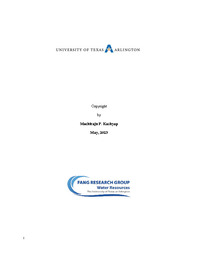| dc.description.abstract | This thesis focuses on investigating the influence of urbanization and development on flow regime and river channel hydraulics in the Bear Creek watershed, Texas using a comprehensive set of hydrologic and 1D/2D coupled hydraulic model. The Bear Creek watershed, located in North Texas, has experienced rapid urbanization and land development in recent years, raising concerns about the potential impacts on hydrological processes and the hydraulic behavior of the river system. To address these concerns, this research utilizes an integrated modeling approach, combining the HEC-HMS and HEC-RAS software tools, to assess changes in flow rates and simulate their effects on river channel hydraulics. The study employs a comprehensive methodology, integrating various data sources such as land use data, precipitation records, and streamflow measurements. HEC-HMS is employed to simulate the hydrologic response of the Bear Creek Watershed under different urbanization and development scenarios, generating flow rates that reflect the altered surface conditions. These flow rates are then utilized as boundary conditions for subsequent 1D/2D simulations in HEC-RAS, allowing for a detailed analysis of the hydraulic behavior of the river channel. The findings of this research shed light on the impact of urbanization and development on flow regime characteristics within the Bear Creek Watershed. Parameters such as peak flows, flow duration curves, and flood routing are analyzed to understand the changes in hydrological patterns resulting from land use alterations. Furthermore, the implications on river channel hydraulics, including water levels, velocities, and shear stresses, are assessed to gain insights into the potential effects on flood risks, sediment transport, and channel stability. By utilizing the integrated modeling capabilities of HEC-HMS and HEC-RAS, this research provides a comprehensive understanding of the complex interactions between urbanization, development, and the hydrological behavior of the Bear Creek Watershed. The outcomes of this study can inform decision-making processes for local authorities, land developers, and environmental managers, facilitating sustainable land use planning and watershed management practices. Overall, this thesis contributes to the knowledge base surrounding the Bear Creek Watershed and serves as a valuable resource for understanding the implications of urbanization and development on flow regime and river channel hydraulics. The integrated modeling approach presented in this research can be applied to other watersheds facing similar challenges, promoting informed decision-making and sustainable development practices in urbanized areas. | |


